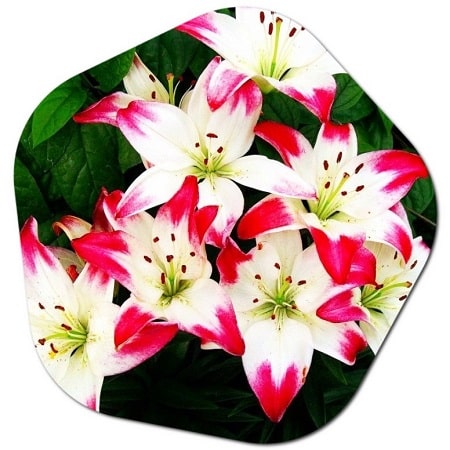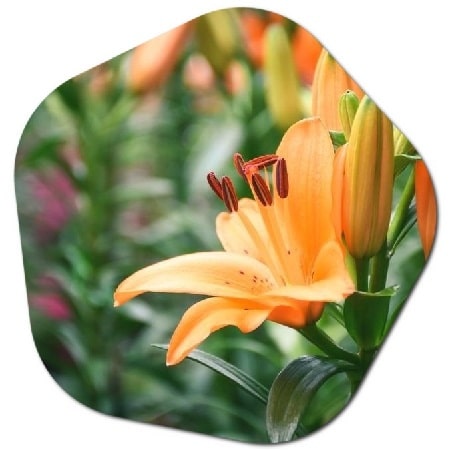Lily flower is a seasonal flower from the Lily family. It is a bulb-rooted plant species and when viewed from the outside, it exhibits a tall, upright stem and large flowered appearance. Since it is a plant that shows rapid growth in a short time, the care of the lily can give extremely positive results. Lily plant; It is very rich in content. In this respect, it is among the medicinal plants from which oil is obtained. In this respect, it is a flower that is cultivated as a flower as well as for the purpose of obtaining oil.
Lilies are a diverse group of flowering plants, and many species and cultivars of lilies can be found growing in various regions of North America. Some lily species are native to North America, while others have been introduced and cultivated. The native species include the wood lily (Lilium philadelphicum) and the Turk’s cap lily (Lilium superbum), among others.

Additionally, various hybrid varieties and cultivars of lilies are commonly grown in gardens across North America. These cultivated lilies come in a wide range of colors, sizes, and forms, making them popular choices for landscaping and floral arrangements. It’s worth noting that lilies are a large and diverse group of plants with species found on multiple continents, so the specific types of lilies you encounter can vary depending on the region and local climate.
In the United States How to Plant Lily Flowers? Lily is a bulbous plant. For this reason, the soil must be processed before planting the bulb. The most suitable planting time for planting the bulbs of the flower is the fall season. If planting in a pot, one bulb is enough for the pot. If it is to be grown in the garden, one lily bulb should be placed every 50 cm. After the lily bulb is placed upright in the soil, it is necessary to throw a little more soil on it than the seed.
How to care for lilies in pots in the USA?
Caring for lilies in pots in the USA involves providing the right growing conditions, proper watering, fertilization, and protection from pests. Here are some general guidelines for caring for potted lilies:
- Container and Soil:
- Choose a large, well-draining container with drainage holes at the bottom. This helps prevent waterlogged soil, which can lead to root rot.
- Use a high-quality, well-draining potting mix. A mix designed for bulbs or perennials is often suitable.
- Planting:
- Plant the lily bulbs in the pot with the pointed end facing up. Plant them at a depth of about two times the height of the bulb.
- Space multiple bulbs according to the specific requirements of the lily variety.
- Sunlight:
- Lilies generally prefer full sun to partial shade. Place the pots where they receive at least 6-8 hours of sunlight per day.
- In hotter climates, providing some afternoon shade can be beneficial.
- Watering:
- Keep the soil consistently moist but not waterlogged. Water when the top inch of soil feels dry.
- Water the soil directly, avoiding wetting the foliage to reduce the risk of fungal diseases.
- Mulch the soil surface to help retain moisture.
- Fertilization:
- Fertilize lilies in pots with a balanced, water-soluble fertilizer. Follow the manufacturer’s instructions for application rates.
- Apply fertilizer in spring when new growth appears and again after flowering.
- Support:
- Tall lily varieties may need support to prevent them from bending or breaking. Use stakes or other support structures to keep the plants upright.
- Deadheading:
- Remove spent flowers to encourage the plant to put energy into bulb development rather than seed production.
- Winter Care:
- In regions with cold winters, consider protecting potted lilies by moving the pots to a sheltered location or insulating them to prevent freezing.
- Mulch the soil surface in late fall to help insulate the bulbs.
- Pest Control:
- Keep an eye out for pests such as aphids or lily beetles. If detected, treat them promptly using appropriate insecticides or manual removal.
- Dormancy:
- Some lily varieties may go dormant after flowering. Allow the foliage to die back naturally before cutting it back.
Always check the specific care requirements for the particular lily variety you are growing, as different types of lilies may have slightly different needs.
Where do lily flowers grow in the United States?
Lilies can be found growing in various regions of the United States, and their distribution depends on factors such as climate, soil conditions, and species variety. Here are some general observations about the distribution of lilies in the United States:

- Native Species:
- Some lily species are native to certain regions of the United States. For example, the wood lily (Lilium philadelphicum) is native to parts of North America, including the central and eastern United States.
- Naturalized and Cultivated Varieties:
- In addition to native species, many cultivated varieties and hybrids of lilies are grown in gardens and landscapes across the country. These may include popular types like Asiatic lilies, Oriental lilies, and Trumpet lilies.
- Gardens and Landscapes:
- Lilies are commonly cultivated in gardens and landscapes throughout the United States. They are appreciated for their vibrant colors, fragrance, and distinctive flower shapes. Many gardeners choose to plant lilies as ornamental flowers.
- Adaptability:
- Lilies are adaptable plants that can thrive in a range of climates. However, specific species and varieties may have preferences for certain growing conditions, such as sun exposure and soil type.
- USDA Hardiness Zones:
- Different lily varieties may be suited to different USDA Hardiness Zones. For example, some lilies may be well-suited to colder zones, while others may thrive in warmer climates.
- Local Nurseries:
- You can find a variety of lily bulbs and plants at local nurseries and garden centers throughout the United States. This allows gardeners to select lilies that are well-suited to their local climate and growing conditions.
It’s important to note that the specific types of lilies and their distribution can vary widely. If you’re interested in growing lilies in a particular region of the United States, it’s a good idea to choose varieties that are well-suited to the local climate and soil conditions. Additionally, some lilies may be better suited to specific regions within the country, so it’s helpful to consider the local climate and USDA Hardiness Zone when selecting lilies for your garden.
